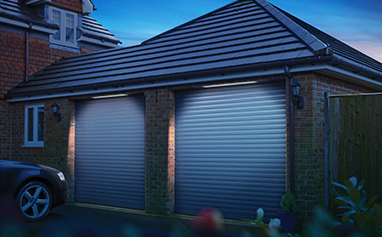What is The Best Lighting for Soffit?
- Topaz Du
- Jan 11, 2023
- 5 min read
Soffit decoration is a great way to add interest to a home's exterior. Soffit lights are an essential part of exterior lighting and provide a subtle, ambient lighting effect, creating a soothing atmosphere, and add a layer of security to the exterior of a home. In this article, we share some exterior soffit lighting ideas.
What is a soffit light?

A soffit light is an electrical lighting fixture that is installed in a soffit, which is an area or recess between two architectural structures, such as a ceiling and a wall. Soffit lighting has become increasingly popular in recent years, due to its efficient and attractive aesthetic. It is often used to accentuate architectural features, such as staircases, columns, or other features of a home.
What is the best lighting for soffit?
Soffit lighting can be used in a variety of ways, from providing general lighting to accentuating a specific feature or area. The type of lighting used depends on the area and the effect desired. Generally, recessed lights are the best choice for soffit lighting, as they are unobtrusive and can provide a soft and even illumination to a space. Other options include string lighting, pendant lights and wall sconces, which can be used to create a more dramatic effect.

When selecting lights for soffits, it is important to consider the size of the soffit, the type of lighting required, and the wattage of the lightbulbs. Generally, it is best to use bulbs with a lower wattage, as this will reduce energy consumption. LED will be a good choice.
Solar lights can be used as soffit lights. Solar lights are a good option for exterior lighting because they do not require any wiring, are energy-efficient, and are easy to install. They are also perfect for outdoor spaces where wiring may be difficult or hazardous. Solar lights typically require a few hours of direct sunlight each day to remain charged and provide illumination. When selecting solar lights, it is important to consider the size of the soffit that needs to be illuminated, the type of illumination desired, and the type of solar panel used.
Where is the best location for soffit lights? Where should exterior soffit lights be placed?
Generally, soffit lights should be placed in areas that are unobtrusive and blend in with the overall design of the home. As they will be visible from the outside, it’s important that they don’t clash with the exterior aesthetic.
Recessed Lights / Spotlights / Pendant Lights / Wall Sconces
The best locations for soffit lights are typically along the eave of a roof and in the area between the roof and the wall. This way, the lights will be out of the way, but still provide adequate lighting. For this placement, soffit lights should be installed at least 6-8 inches from the roof’s edge, and be spaced evenly along the soffit.
String Lights / Strip Lights
The best location to install string lights for soffit lighting is at the top of the soffit, close to the roofline. This will allow the lights to be out of the way and provide ample light without being too intrusive. It is important that the string lights are far enough away from any other lighting sources to avoid glare. It is also important to ensure that the area is ventilated and the lights are not too close to any combustible materials. The string lights should be secured firmly, either with screws or cable ties, to ensure that they remain in place. It is also important to ensure that the string lights are rated for outdoor use and have appropriate weatherproofing.
Additionally, the lights should be installed in an area that is not exposed to the elements, such as under a porch or awning if the lights are not weatherproof. Lastly, the lights should be placed in an area that is not too close to people or animals, as this may present a safety hazard.
How far apart should exterior soffit lights be?
When it comes to selecting the proper spacing for soffit lights, there are a few important factors to consider.
#1, Size of the soffit lighting
The first and most important factor to consider is the size of the soffit lighting fixture. Different sizes of fixtures require different distances between each light. For example, a large-scale soffit light will require a larger distance between each fixture than a smaller-scale fixture. It is important to measure the distance between each fixture, as well as the size of the fixture itself, to ensure the proper spacing is maintained.
#2, Purpose of the soffit lights
The second factor to consider is the purpose of the soffit lights. If the lights are being used to accentuate architectural features, they should be placed close together to create a dramatic effect. However, if the lights are being used as security lighting, they should be placed further apart to maximize their coverage area.
The third factor to consider is the lumen of the lights. The lumen will determine how bright the lights will be and should be adjusted to fit the size of the soffit. If a soffit is small, lower-lumen lights will be more than sufficient, while larger soffits may require higher-lumen lights. You can also use low-lumen lights for the large soffits, then the distance between light to light should be shorter.
#4, Light range affects the spacing for soffit lights
Fourthly, the light range. Light range is affected by the size and shape of the fixture being used. Some lighting fixtures will provide a wider range of light coverage, while others will provide a more focused light. The spacing of the soffit lights is determined by the lighting range and the angle of the light being produced. The wider range the fixture produces, the farther apart the soffit lights should be spaced in order to adequately illuminate the area.
How bright should soffit lights be? How many lumens should soffit lights be?
Soffit lights not only add aesthetic value, but they also provide important safety benefits. Soffit lights can help to light pathways, steps, and other areas that can be difficult to see in the dark. As such, it is important to select the right brightness and lumens for your soffit lights.

The brightness of soffit lights should be determined by both the size of the area they are illuminating, as well as the type of light fixture being used. For smaller areas, such as walkways, steps, or patios, a low-intensity light is usually sufficient. These types of soffit lights will typically have a lumen count of 200-400 lumens. For larger areas, such as decks or driveways, more powerful lights may be required. A higher lumen count of 500-1000 lumens will be necessary.
However, if you are only looking for a subtle effect and want to make the house look beautiful at night, you should opt for soffit lights that are not too bright.

For a subtle effect, you should select soffit lights with a lumen rating of no more than 800, which will create a soft, gentle light.
In addition to the lumen rating, you should also consider the color temperature of the soffit lights. This is measured in kelvins, and the higher the kelvin rating, the whiter and brighter the light will be. For a subtle effect, you should select soffit lights with a kelvin rating of no more than 3000K.
_edited.jpg)

































Comments